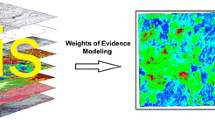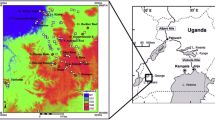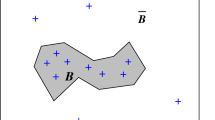Abstract
The weights-of-evidence method provides a simple approach to the integration of diverse geologic information. The application addressed is to construct a model that predicts the locations of epithermal-gold mineral deposits in the Great Basin of the western United States. Weights of evidence is a data-driven method requiring known deposits and occurrences that are used as training sites in the evaluated area. Four hundred and fifteen known hot spring gold–silver, Comstock vein, hot spring mercury, epithermal manganese, and volcanogenic uranium deposits and occurrences in Nevada were used to define an area of 327.4 km2 as training sites to develop the model. The model consists of nine weighted-map patterns that are combined to produce a favorability map predicting the distribution of epithermal-gold deposits. Using a measure of the association of training sites with predictor features (or patterns), the patterns can be ranked from best to worst predictors. Based on proximity analysis, the strongest predictor is the area within 8 km of volcanic rocks younger than 43 Ma. Being close to volcanic rocks is not highly weighted, but being far from volcanic rocks causes a strong negative weight. These weights suggest that proximity to volcanic rocks define where deposits do not occur. The second best pattern is the area within 1 km of hydrothermally altered areas. The next best pattern is the area within 1 km of known placer-gold sites. The proximity analysis for gold placers weights this pattern as useful when close to known placer sites, but unimportant where placers do not exist. The remaining patterns are significantly weaker predictors. In order of decreasing correlation, they are: proximity to volcanic vents, proximity to east-west to northwest faults, elevated airborne radiometric uranium, proximity to northwest to west and north-northwest linear features, elevated aeromagnetics, and anomalous geochemistry. This ordering of the patterns is a function of the quality, applicability, and use of the data. The nine-pattern favorability map can be evaluated by comparison with the USGS National Assessment for hot spring gold–silver deposits. The Spearman's ranked correlation coefficient between the favorability and the National Assessment permissive tracts is 0.5. Tabulations of the areas of agreement and disagreement between the two maps show 74% agreement for the Great Basin. The posterior probabilities for 51 significant deposits in the Great Basin, both used and not used in the model, show the following: 26 classified as favorable; 25 classified as permissive; and 1, Florida Canyon, classified as nonpermissive.The Florida Canyon deposit has a low favorability because there are no volcanic rocks near the deposit on the Nevada geologic map used. The largest areas of disagreement are caused by the USGS National Assessment team concluding that volcanic rocks older than 27 Ma in Nevada are not permissive, which was not assumed in this model. The weights-of-evidence model is evaluated as reasonable and delineates permissive areas for epithermal deposits comparable to expert's delineation. The weights-of-evidence model has the additional characteristics that it is well defined, reproducible, objective, and provides a quantitative measure of confidence.
Similar content being viewed by others
REFERENCES
Bonham-Carter, G. F., (1994), Geographic information systems for geoscientists-modeling in GIS: Elsevier Science, New York, 398 p.
Bonham-Carter, G. F., Agterberg, F. P., and Wright, D. F., 1988, Integration of geological datasets for gold exploration in Nova Scotia: Photogrammetric Eng., v. 54,no. 11, p. 1585–1592.
Bonham-Carter, G. F., Agterberg, F. P., and Wright, D. F., 1989, Weights of evidence modeling—a new approach to mapping mineral potential, in Agterberg, F. P., and Bonham-Carter, G. F., eds., Statistical Applications in the Earth Sciences: Geol. Survey Canada Paper 9–9, p. 171–183.
Bussey, S. D., 1996, Gold mineralization and associated rhyolitic volcanism at the Hog Ranch District, northwest Nevada, in Coyner, A. R., and Fahey, P. L., eds., Geology and Ore Deposits of the American Cordillera: Geol. Soc. Nevada Proc. (Renov/Sparks, Nevada), p. 181–207.
Conover, W. J., 1971, Practical nonparametric statistics: John Wiley & Sons, New York, Table 10, 390 p.
Cox, D. P., and Singer, D. A., 1986, Mineral deposit models: U.S. Geol. Survey Bull. 1693, 379 p.
Davis, J. C., 1986, Statistics and data analysis in geology (2nd edn.): John Wiley & Sons, New York, p. 98–100.
Kemp, L., Bonham-Carter, G. F., and Raines, G. L., 1999, ArcWotE: Arcview extension for weights of evidence mapping: http://gis.nrcan.gc.ca/software/arcview/wofe.
King, J. L., and Kramer, K. L., 1993, Models, facts, and the policy process—the political ecology of estimated truth, in Goodchild, M. F., Parks, B. O., and Steyaert, L. T., eds., Environmental Modeling with GIS: Oxford Univ. Press, New York, p. 353–360.
King, P. B., and Beikman, H. M., 1974, Geologic map of the United States: U.S. Geol. Survey, 3 plates, scale 1:2,500,00
Ludington, S., and Cox, D., eds., 1996, Data base for a national mineral-resource assessment of undiscovered deposits of gold, silver, copper, lead and zine in the conterminous United States: U.S. Geol. Survey Open-File Rept. 96–96, CD-ROM.
Ludington, Steve, Orris, G. J., and Cox, D. P., 1992, Methods of resource assessment, in Bleiwas, D. I., and Christiansen, R. G., eds., Geology and Mineral Resources of the Altiplano and Cordillera, Bolivia, with a Section on Applications of Economic Evaluations to Deposit Models: U.S. Geol. Survey Bull. 1975. p. 218–219.
Ludington, S., Cox, D. P., Sherlock, M. G., Singer, D. A., Berger, B. R., and Tingley, J., 1993, Spatial and temporal analysis of precious-metal deposits for a mineral resource assessment of Nevada, in Kirkham, R. V., Sinclair, R. V., Thorpe, W. D., and Duke, J. M., eds., Mineral Deposit Modeling: Geol. Assoc. Canada Spec. Paper 40, p. 31–40.
Raines, G. L., Sawatzky, D. L., and Connors, K. A., 1996, Great Basin geoscience data base: U.S. Geol. Survey Digital Data Series 41 (DDS-41), 2 CD-ROMs.
Sherlock, M. G., Cox, D. P., and Huber, D. F., 1996, Known mineral deposits and occurrences in Nevada, Chapter 10, in Singer, D. A., ed., An Analysis of Nevada's Metal-Bearing Mineral Resources: Nevada Bureau Mines and Geology, Open-File Rept. 96–2, 38p.
Stewart, J. H., and Carlson, J. E., 1978. Geologic map of Nevada: U.S. Geol. Survey, 2 sheets, scale 1:500,000.
Walker, G. W., and MacLeod, N. S., 1991, Geologic map of Oregon, U.S. Geological Survey, 2 plates, scale 1:500,000.
Wright, D. F., 1996, Evaluating volcanic hosted massive sulphide favourability using GIS-based spatial data integration models, Snow Lake area, Manitoba: unpubl. doctoral dissertation, Univ. Ottawa, 344 p. and CD-ROM with data.
Wright, D. F., and Bonham-Carter, G. F., 1996, VHMS favourability mapping with GIS-based integration models, Chisel Lake-Anderson Lake area, in Bonham-Carter, G. F., Galley, A. G., and Hall, G. E. M., eds., EXTECH I, A Multidisciplinary Approach to Massive Sulphide Research in the Rusty Lake-Snow Lake Greenstone Belts, Manitoba: Geol. Survey Canada Bull. 426, p. 339–376, 387–401.
Author information
Authors and Affiliations
Corresponding author
Rights and permissions
About this article
Cite this article
Raines, G.L. Evaluation of Weights of Evidence to Predict Epithermal-Gold Deposits in the Great Basin of the Western United States. Natural Resources Research 8, 257–276 (1999). https://doi.org/10.1023/A:1021602316101
Issue Date:
DOI: https://doi.org/10.1023/A:1021602316101




